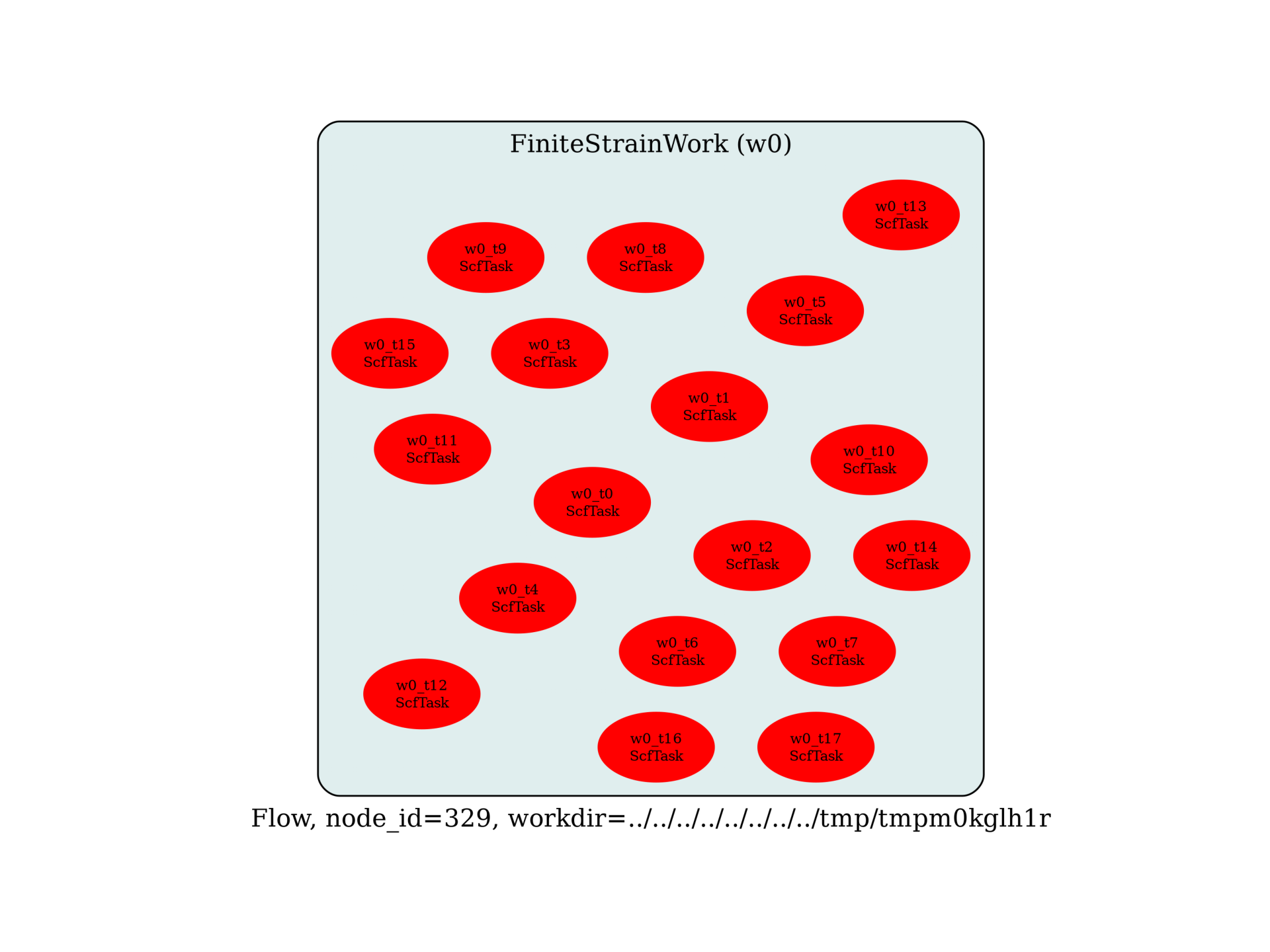Note
Go to the end to download the full example code.
FOO BAR
Flow to compute with finite differences.
Finite electric field calculation of AlP at clamped atomic positions
Here the polarization of the cell is computed as a function of increasing external homogeneous electric field.
berryopt 4 is used to trigger the finite field calculation, while the efield variable sets the strength (in atomic units) and direction of the field
Based on tutorespfn/Input/tpolarization_6.abi

import sys
import os
import abipy.flowtk as flowtk
from abipy.core.structure import Structure
from abipy.abio.inputs import AbinitInput
from abipy.flowtk.finitediff import FiniteStrainWork
def build_flow(options):
# Set working directory (default is the name of the script with '.py' removed and "run_" replaced by "flow_")
if not options.workdir:
options.workdir = os.path.basename(sys.argv[0]).replace(".py", "").replace("run_", "flow_")
structure = Structure.from_abistring("""
# Definition of the unit cell
acell 3*7.2728565836E+00
rprim
0.0000000000E+00 7.0710678119E-01 7.0710678119E-01
7.0710678119E-01 0.0000000000E+00 7.0710678119E-01
7.0710678119E-01 7.0710678119E-01 0.0000000000E+00
natom 2 # two atoms in the cell
typat 1 2 # type 1 is Phosphorous, type 2 is Aluminum (order defined by znucl above and pseudos list)
# Definition of the atom types and pseudopotentials
ntypat 2 # two types of atoms
znucl 15 13 # the atom types are Phosphorous and Aluminum
#atomic positions, given in units of the cell vectors. Thus as the cell vectors
#change due to strain the atoms will move as well.
xred
1/4 1/4 1/4
0 0 0
""")
# Get NC pseudos from pseudodojo.
from abipy.flowtk.psrepos import get_oncvpsp_pseudos
pseudos = get_oncvpsp_pseudos(xc_name="LDA", version="0.4",
relativity_type="SR", accuracy="standard")
#nspinor = 1
#nsppol, nspden = 1, 4
#if nspinor == 1:
# nsppol, nspden = 2, 2
#nband 4
# nband is restricted here to the number of filled bands only, no empty bands. The theory of
# the Berrys phase polarization formula assumes filled bands only. Our pseudopotential choice
# includes 5 valence electrons on P, 3 on Al, for 8 total in the primitive unit cell, hence
# 4 filled bands.
scf_input = AbinitInput(structure, pseudos)
num_ele = scf_input.num_valence_electrons
scf_input.set_vars(
ecut=5,
nband=4,
tolvrs=1.0e-8,
#toldfe=1.0e-15,
#nspinor=nspinor,
#nsppol=nsppol,
#nspden=nspden,
#nstep=7, # Maximal number of SCF cycles from the tutorial
nstep=50, # Maximal number of SCF cycles
ecutsm=0.5,
dilatmx=1.05,
paral_kgb=0,
)
shiftk = [0.5, 0.5, 0.5,
0.5, 0.0, 0.0,
0.0, 0.5, 0.0,
0.0, 0.0, 0.5,
]
#scf_input.set_kmesh(ngkpt=[6, 6, 6], shiftk=shiftk)
scf_input.set_kmesh(ngkpt=[1, 1, 1], shiftk=[0, 0, 0])
# Initialize the flow.
flow = flowtk.Flow(workdir=options.workdir, manager=options.manager)
fd_accuracy = 2
relax_ions = True
relax_ions_opts = None
work = FiniteStrainWork.from_scf_input(
scf_input,
fd_accuracy=fd_accuracy,
norm_step=0.005,
shear_step=0.03,
relax_ions=relax_ions,
relax_ions_opts=relax_ions_opts,
#extra_abivars=dict(berryopt=-1), # This to compute the polarization at E = 0
)
# Add the work to the flow.
flow.register_work(work)
return flow
# This block generates the thumbnails in the AbiPy gallery.
# You can safely REMOVE this part if you are using this script for production runs.
if os.getenv("READTHEDOCS", False):
__name__ = None
import tempfile
options = flowtk.build_flow_main_parser().parse_args(["-w", tempfile.mkdtemp()])
build_flow(options).graphviz_imshow()
@flowtk.flow_main
def main(options):
"""
This is our main function that will be invoked by the script.
flow_main is a decorator implementing the command line interface.
Command line args are stored in `options`.
"""
return build_flow(options)
if __name__ == "__main__":
sys.exit(main())
Total running time of the script: (0 minutes 0.460 seconds)